Chevrolet Corvette
| Chevrolet Corvette | |
|---|---|
 | |
 | |
| Overview | |
| Manufacturer | Chevrolet (General Motors) |
| Also called |
Sting Ray (1963–1967) Stingray (1969–1976, 2014–present) |
| Production | 1953–present |
| Model years |
1953–1982, 1984–present |
| Assembly | |
| Body and chassis | |
| Class | Sports car |
| Body style |
2-door coupé 2-door convertible |
| Layout |
|
| Powertrain | |
| Engine |
|
The Chevrolet Corvette, known colloquially as the Vette,[1] or Chevy Corvette, is a sports car manufactured by Chevrolet. The car has been produced through seven generations.[2][3] The first model, a convertible, was introduced at the GM Motorama in 1953 as a concept show car. Myron Scott is credited for naming the car after the type of small, maneuverable warship called a corvette.[4] Originally built in Flint, Michigan and St. Louis, Missouri, the Corvette is currently manufactured in Bowling Green, Kentucky and is the official sports car of the Commonwealth of Kentucky.
History
First generation (C1; 1953–1962)

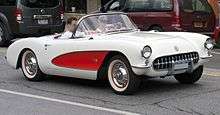
.jpg)

The first generation of Corvette was introduced late in the 1953 model year. Originally designed as a show car for the 1953 Motorama display at the New York Auto Show, it generated enough interest to induce GM to make a production version to sell to the public. First production was on June 30, 1953.[5][6][7]
This generation was often referred to as the "solid-axle" models (the independent rear suspension was not introduced until the second generation).[8] 300 hand-built polo white Corvette convertibles were produced for the 1953 model year.[9]
The 1954 model year vehicles could be ordered in Pennant Blue, Sportsman Red, Black, or Polo White. 3,640 were built, and sold slowly.
The 1955 model offered a 265 cu in (4.34 L) V8 engine as an option. With a large inventory of unsold 1954 models, GM limited production to 700 for 1955. With the new V8, the 0-60 mph time improved by 1.5 seconds.[7]
A new body was introduced for the 1956 model featuring a new "face" and side coves; the taillamp fins were also gone.[10] An optional fuel injection system was made available in the middle of the 1957 model year. It was one of the first mass-produced engines in history to reach 1 bhp (0.75 kW) per cubic inch (16.4 cubic cm) and Chevrolet's advertising agency used a "one hp per cubic inch" slogan for advertising the 283 bhp (211 kW) 283 cu in (4.64 L) Small-Block engine.[11] Other options included power windows (1956), hydraulically operated power convertible top (1956), heavy duty brakes and suspension (1957), and four speed manual transmission (late 1957).[11] Delco Radio transistorized signal-seeking "hybrid" car radio, which used both vacuum tubes and transistors in its radio's circuitry (1956 option).[12][13]
The 1958 Corvette received a body and interior freshening which included a longer front end with quad headlamps, bumper exiting exhaust tips, a new steering wheel, and a dashboard with all gauges mounted directly in front of the driver.[14] Exclusive to the 1958 model were hood louvers and twin trunk spears.[14] The 1959–60 model years had few changes except a decreased amount of body chrome and more powerful engine offerings.[15]
In 1961, the rear of the car was completely redesigned with the addition of a "duck tail" with four round lights. The light treatment would continue for all following model year Corvettes until 2014.[16] In 1962, the Chevrolet 283 cu in (4.64 L) Small-Block was enlarged to 327 cu in (5.36 L). In standard form it produced 250 bhp (190 kW). For an extra 12% over list price, the fuel-injected version produced 360 bhp (270 kW),[17] making it the fastest of the C1 generation. 1962 was also the last year for the wrap around windshield, solid rear axle, and convertible-only body style.[18] The trunk lid and exposed headlamps did not reappear for many decades.[19]
Second generation (C2; 1963–1967)
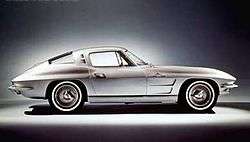
The second generation (C2) Corvette, which introduced Sting Ray to the model, continued with fiberglass body panels, and overall, was smaller than the first generation. The C2 was later referred to as mid-years.[20] The car was designed by Larry Shinoda with major inspiration from a previous concept design called the "Q Corvette," which was created by Peter Brock and Chuck Pohlmann under the styling direction of Bill Mitchell.[21] Earlier, Mitchell had sponsored a car known as the "Mitchell Sting Ray" in 1959 because Chevrolet no longer participated in factory racing. This vehicle had the largest impact on the styling of this generation, although it had no top and did not give away what the final version of the C2 would look like.[22] The third inspiration was a Mako Shark Mitchell had caught while deep-sea fishing.[23]
Production started for the 1963 model year and ended in 1967. Introducing a new name, "Sting Ray", the 1963 model was the first year for a Corvette coupé and it featured a distinctive tapering rear deck (a feature that later reappeared on the 1971 "Boattail" Buick Riviera) with, for 1963 only, a split rear window. The Sting Ray featured hidden headlamps, non-functional hood vents, and an independent rear suspension.[24] Corvette chief engineer Zora Arkus-Duntov never liked the split rear window because it blocked rear vision, but Mitchell thought it to be a key part of the entire design. Maximum power for 1963 was 360 bhp (270 kW) and was raised to 375 bhp (280 kW) in 1964. Options included electronic ignition, the breakerless magnetic pulse-triggered Delcotronic first offered on some 1963 Pontiac models.[25] On 1964 models the decorative hood vents were eliminated and Duntov, the Corvette's chief engineer, got his way with the split rear window changed to a full width window.
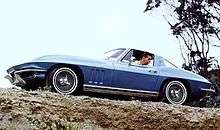
Four-wheel disc brakes were introduced in 1965, as was a "big block" engine option: the 396 cu in (6.49 L) V8. Side exhaust pipes were also optionally available in 1965, and continued to be offered through 1967. The introduction of the 425 bhp (317 kW) 396 cu in (6.49 L) big block in 1965 spelled the beginning of the end for the Rochester fuel injection system.[26] The 396 cu in (6.49 L) option cost US$292.70 while the fuel injected 327 cu in (5.36 L) engine cost US$538.00. Few people could justify spending US$245.00 more for 50 bhp (37 kW) less, even though FI could deliver over 20 mpg on the highway and would keep delivering fuel despite high G-loading in corners taken at racing speeds. Another rare '63 and '64 option was the Z06 competition package, which offered stiffer suspension, bigger, multi-segment lined brakes with finned drums and more, only a couple hundred coupes and ONE convertible were factory-equipped this way in 1963. With only 771 fuel-injected cars built in 1965, Chevrolet discontinued the option at the end of the '65 production, having introduced a less-expensive big block 396 engine rated at 425 hp in the middle of the production year and selling over 2,000 in just a few months. For 1966, Chevrolet introduced an even larger 427 cu in (7.00 L) Big Block version. Other options available on the C2 included the Wonderbar auto-tuning AM radio, AM-FM radio (mid-1963), air conditioning (late-1963), a telescopic steering wheel (1965), and headrests (1966). The Sting Ray's independent rear suspension was successfully adapted for the new-for-1965 Chevrolet Corvair, which solved the quirky handling problems of that unique rear-engine compact.[27]

1967 was the final year for the C2 generation. The 1967 model featured restyled fender vents, less ornamentation, and back-up lamps which were on the inboard in 1966 were now rectangular and centrally located. The first use of all four taillights in red started in 1961 and was continued thru the C-2 line-up except for the 1966. The 1967 and subsequent models continuing on all Corvettes since. 1967 had the first L88 engine option which was rated at 430 bhp (320 kW), but unofficial estimates place the actual output at 560 bhp (420 kW) or more.[28] Only twenty such engines were installed at the factory. From 1967 (to 1969), the Holley triple two-barrel carburetor, or Tri-Power, was available on the 427 L89 (a $368 option, on top of the cost for the high-performance 427).[29] Despite these changes, sales slipped over 15%, to 22,940 (8,504 coupes, off close to 15%, and 14,436 convertibles, down nearly 19%).[30]
Duntov came up with a lightweight version of the C2 in 1962. Concerned about Ford and what they were doing with the Shelby Cobra, GM planned to manufacture 100 Grand Sport Corvettes, but only five were actually built.[31] They were driven by historic drivers such as Roger Penske, A. J. Foyt, Jim Hall, and Dick Guldstrand among others. Today the five cars (001-005) are all held by private owners, and are among the most coveted and valuable Corvettes ever built.[32] 002 is exhibited in the Simeone Foundation Automotive Museum and is in running condition.[33]
Third generation (C3; 1968–1982)
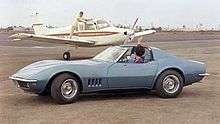

The third generation Corvette, patterned after the Mako Shark II concept car, was introduced for the 1968 model year and was in production until 1982. C3 coupes featured the first use of T-top removable roof panels. It introduced monikers that were later revived, such as LT-1, ZR-1, Z07 and Collector Edition. In 1978, the Corvette's 25th anniversary was celebrated with a two-tone Silver Anniversary Edition and an Indy Pace Car replica edition of the C3. This was also the first time that a Corvette was used as a Pace Car for the Indianapolis 500.[34]
Engines and chassis components were mostly carried over from the C2, but the body and interior were new. The 350 cu in (5.7 L) engine replaced the old 327 cu in (5.36 L) as the base engine in 1969, but power remained at 300 bhp (224 kW). 1969 was the only year for a C3 to optionally offer either a factory installed side exhaust or normal rear exit with chrome tips. The all-aluminum ZL1 engine was also new for 1969; the special big-block engine was listed at 430-hp (320 kW), but was reported to produce 560 hp (420 kW) and propelled a ZL1 through the 1/4 mile in 10.89 seconds.[35]
There was an extended production run for the 1969 model year due a lengthy labor strike, which meant sales were down on the 1970 models, to 17,316.[36] 1970 small-block power peaked with the optional high compression, high-revving LT-1 that produced 370 bhp (276 kW). The 427 big-block was enlarged to 454 cu in (7.44 L) with a 390 bhp (291 kW) rating. The ZR-1 special package was an option available on the 1970 through 1972 model years, and included the LT-1 engine combined with special racing equipment. Only 53 ZR-1's were built.[37]
In 1971, to accommodate regular low-lead fuel with lower anti-knock properties, the engine compression ratios were lowered which resulted in reduced power ratings. The power rating for the 350 cu in (5.7 L) L48 base engine decreased from 300 to 270 horsepower and the optional special high performance LT1 engine decreased from 370 to 330 horsepower. The big-block LS6 454 was reduced from 450 to 425 bhp (317 kW), though it was not used in Corvettes for 1970; it was used in the Chevelle SS. For the 1972 model year, GM moved to the SAE Net measurement which resulted in further reduced, but more realistic, power ratings than the previous SAE Gross standard.[38] Although the 1972 model's 350 cu in (5.7 L) horsepower was actually the same as that for the 1971 model year, the lower net horsepower numbers were used instead of gross horsepower. The L48 base engine was now rated at 200 bhp (150 kW) and the optional LT1 engine was now rated at 270 bhp (200 kW).[19] 1974 models had the last true dual exhaust system that was dropped on the 1975 models with the introduction of catalytic converters requiring the use of no-lead fuel. Engine power decreased with the base ZQ3 engine producing 165 bhp (123 kW), the optional L82's output 250 bhp (186 kW), while the 454 big-block engine was discontinued. Gradual power increases after 1975 peaked with the 1980 model's optional L82 producing 230 bhp (172 kW).[15]
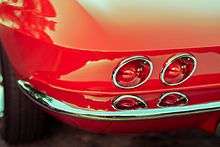
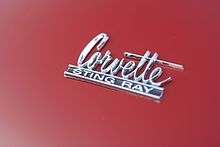
Styling changed subtly throughout the generation until 1978 for the car's 25th anniversary. The Sting Ray nameplate was not used on the 1968 model, but Chevrolet still referred to the Corvette as a Sting Ray; however, the 1969 (through 1976) models used the "Stingray" name as one word, without the space.[39] In 1970, the body design was updated including fender flares, and interiors were refined, which included redesigned seats,and indication lights near the gear shift that were an early use of fiber optics . Due to government regulation, the 1973 Corvette's chrome front bumper was changed to a 5-mile-per-hour (8 km/h)system with a urethane bumper cover.[40] 1973 Corvettes are unique in that sense, as they are the only year where the front bumper was polyurethane and the rear retained the chrome two-piece bumper set. 1973 was also the last year chrome bumpers were used. The optional wire-spoked wheel covers (left) were offered for the last time in 1973. Only 45 Z07 were built in 1973. From 1974 onwards both the front and rear bumpers were polyurethane.[6]
In 1974, a 5-mile-per-hour (8 km/h) rear bumper system with a two-piece, tapering urethane bumper cover replaced the Kamm-tail and chrome bumper blades, and matched the new front design from the previous year. 1975 was the last year for the convertible, (which did not return for 11 years) and Dave McLellan succeeded Zora Arkus-Duntov as the Corvette's Chief Engineer.[41] For the 1976 models the fiberglass floor was replaced with steel panels to provide protection from the catalytic converter's high operating temperature. For 15 model years the names Corvette, Sting Ray, and Stingray were synonymous. 1977 was last year the tunneled roof treatment with vertical back window was used, in addition leather seats were available at no additional cost for the first time. The black exterior color returned after a six-year absence.[42]

The 1978 25th Anniversary model introduced the fastback glass rear window and featured a new interior and dashboard. Corvette's 25th anniversary was celebrated with the Indy 500 Pace Car limited edition and a Silver Anniversary model featuring silver over gray lower body paint. All 1979 models featured the previous year's pace car seats and offered the front and rear spoilers as optional equipment.[20] 53,807 were produced for the model year, making 1979 the peak production year for all versions of the Corvette. Sales have trended downward since then.[43] In 1980, the Corvette received an integrated aerodynamic redesign that resulted in a significant reduction in drag. After several years of weight increases, 1980 Corvettes were lighter as engineers trimmed both body and chassis weight.[14] In mid-1981, production shifted from St. Louis, Missouri to Bowling Green, Kentucky, and several two-tone paint options were offered. The 1981 models were the last available with a manual transmission until well into the 1984 production run. In 1982, a fuel-injected engine returned, and a final C3 tribute Collectors Edition featured an exclusive, opening rear window hatch.[14]
Fourth generation (C4; 1984–1996)
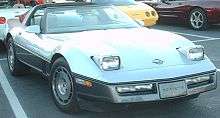

The fourth generation Corvette was the first complete redesign of the Corvette since 1963. Production was to begin for the 1983 model year but quality issues and part delays resulted in only 43 prototypes for the 1983 model year being produced that were never sold. All of the 1983 prototypes were destroyed or serialized to 1984 except one with a white exterior, medium blue interior, L83 350 ci, 205 bhp V8, and 4-speed automatic transmission.[5] After extensive testing and modifications were completed, it was initially retired as a display sitting in an external wall over the Bowling Green Assembly Plant's employee entrance. Later this only surviving 1983 prototype was removed, restored and is now on public display at the National Corvette Museum in Bowling Green, Kentucky. It is still owned by GM.[44][45] On February 12, 2014, it was nearly lost to a sinkhole which opened up under the museum. Eight Corvettes were lost.[46]
Regular fourth generation production began on January 3, 1983; the 1984 model year and delivery to customers began in March 1983. The 1984 model carried over the 350 cu in (5.7 L) L83 slightly more powerful (5 bhp) "Crossfire" V8 engine from the final 1982 third generation model.[20] New chassis features were aluminum brake calipers and an all-aluminum suspension for weight savings and rigidity. The new one piece targa top had no center reinforcement. A new electronic dashboard with digital liquid crystal displays for the speedometer and tachometer was standard. Beginning in 1985, the 230 bhp (170 kW) L98 engine with tuned port fuel injection became the standard engine.[5]
.jpg)
September 1984 through 1988 Corvettes offered a Doug Nash designed "4+3" transmission – a 4-speed manual coupled to an automatic overdrive on the top three gears. It was designed to help the Corvette meet U.S. fuel economy standards.[47] Since 1981 (when it was last offered), a manual transmission returned to the Corvette starting with production in late-1984. The transmission proved to be problematic and was replaced by a modern ZF 6-speed manual transmission in 1989.[48]
In 1986, the second Corvette Indy Pace Car was released. It was the first convertible Corvette since 1975. A Center High Mounted Signal Light (CHMSL) – a third center brake light – was added in 1986 to comply with safety regulations. While the color of the pace car used in the race was yellow, all 1986 convertibles also had an Indy 500 emblem mounted on the console, making any color a "pace car edition". In 1987, the B2K twin-turbo option became available from the factory. The Callaway Corvette was a Regular Production Option (RPO B2K). The B2K option coexisted from 1990 to 1991 with the ZR-1 option, which then replaced it. Early B2Ks produced 345 bhp (257 kW) and 450 lb·ft (610 N·m);[49] later versions boasted 450 bhp (336 kW) and 613 lb·ft (831 N·m).[50]
1988 saw the 35th Anniversary Edition of the Corvette. Each of these featured a special badge with an identification number mounted next to the gear selector, and were finished with a white exterior, wheels, and interior.[14] In 1991, all Corvettes received updates to the body, interior, and wheels. The convex rear fascia that set the 1990 ZR-1 apart from the base model was now included on L98 Corvettes, making the styling of the expensive ZR-1 even closer to that of the base cars. The most obvious difference remaining between the base and ZR-1 models besides the wider rear wheels was the location of the CHMSL, which was integrated into the new rear fascia used on the base model, but remained at the top of the rear-hatch on the ZR-1's.[19]
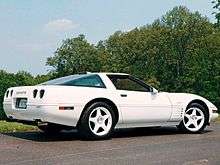
For the 1992 model year, the 300 bhp (220 kW) LT1 engine was introduced, an increase of 50 bhp (37 kW) over 1991's L98 engine. This engine featured reverse-flow cooling (the heads were cooled before the block), which allowed for a higher compression ratio of 10.5:1. A new distributor was also debuted. Called "Optispark", the distributor was driven directly off the front of the camshaft and mounted in front of the timing cover, just above the crankshaft and harmonic balancer.[19] Also new for 1992 was Acceleration Slip Regulation (ASR), a form of traction control which utilized the Corvette's brakes, spark retard, and throttle close-down to prevent excessive rear wheel spin and possible loss of control. The traction control device could be switched off if desired.[14]
A special 40th Anniversary Edition was released in 1993, which featured a commemorative Ruby Red color, 40th anniversary badges, and embroidered seat backs. The 1993 Corvette also marked the introduction of the Passive Keyless Entry System, making it the first GM car to feature it. Production of the ZR-1 ended in 1995, after 6,939 cars had been built.[47] 1996 was the final year of C4 production, and featured special models and options, including the Grand Sport and Collector Edition, OBD II (On-Board Diagnostics), run flat tires, and the LT4 engine. The 330 bhp (246 kW) LT4 V8 was available only with a manual transmission, while all 300 bhp (224 kW) LT1 Corvettes used automatic transmissions.[26]

Chevrolet released the Grand Sport (GS) version in 1996 to mark the end of production of the C4 Corvette. The Grand Sport moniker was a nod to the original Grand Sport model produced in 1963. A total of 1,000 GS Corvettes were produced, 810 as coupes and 190 as convertibles.[26] The 1996 GS came with the high-performance LT4 V8 engine, producing 330 bhp (246 kW) and 340 lb·ft (460 N·m). The Grand Sport came only in Admiral Blue with a white stripe down the middle, and black wheels and two red stripes on the front left wheel arch.[51]
Fifth generation (C5; 1997–2004)
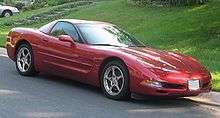
.jpg)
Production of the C5 Corvette began in 1997 and ended with the 2004 model year. The C5 had a top speed of 181 mph (291 km/h) and was judged by the automotive press as improved in nearly every area over the previous Corvette design with the inclusion of a torque tube and rear mounted transmission and differential along with the car's much increased structural rigidity and much more curvaceous design.[52]
Also introduced with the C5 was GM's new LS1 small block. This third-generation small block V8 was completely redesigned. Now all-aluminum, it featured a distributor-less ignition and a new cylinder firing order. It was initially rated at 345 bhp (257 kW) and 350 lb·ft (470 N·m), but was increased to 350 bhp (260 kW) in the 2001 edition. The new engine, combined with the new body and its low 0.29 drag coefficient, was able to achieve up to 28 mpg on the highway.[53]

For its first year, the C5 was available only as a coupe, although the new platform was designed from the ground up to be a convertible, which returned in 1998, followed by the fixed-roof coupe (FRC) in 1999. One concept for the FRC was for it to be a stripped-down model with a possible V6 engine (nicknamed in-house as the "Billy Bob").[54] By 2000, FRC plans laid the groundwork for the return in 2001 of the Z06, an RPO option not seen since Zora's 1963 race-ready Corvette.[55]
The Z06 model replaced the FRC model as the highest performance C5 Corvette. Instead of a heavier double-overhead cam engine like the ZR-1 of the C4 generation, the Z06 used an LS6, a 385 bhp (287 kW) derivative of the standard LS1 engine. Using the much more rigid fixed roof design allowed the Z06 unprecedented handling thanks to upgraded brakes and less body flex.[56] Those characteristics, along with the use of materials such as a titanium exhaust system and a carbon fiber hood in the 2004 model year, led to further weight savings and performance gains for the C5 Z06. The LS6 was later upgraded to 405 bhp (302 kW)for 2002–2004. Although the Z06's rated power output equal to that of the C4 ZR-1, the improved rigidity, suspension, brakes, and reduced weight of the C5 produced a car quicker than C4 ZR-1.[57]
Sixth generation (C6; 2005–2013)
_%E2%80%93_Frontansicht%2C_16._April_2011%2C_D%C3%BCsseldorf.jpg)
.jpg)
The C6 Corvette retained the front engine and rear transmission design of the C5, but was otherwise all-new, including new bodywork with exposed headlamps (for the first time since 1962), a larger passenger compartment, a new 6.0 liter engine and a reworked suspension geometry.[15] It had a longer wheelbase than the C5, but its overall vehicle length and width were less than the C5, allegedly to widen appeal to the European market. The 6.0 L (364 cu in) LS2 V8 produced 400 bhp (300 kW) at 6000 rpm and 400 lb·ft (540 N·m) at 4400 rpm, giving the vehicle a 0–60 mph time of under 4.2 seconds.[58] Its top speed was 190 mph (310 km/h).
The C6 generation did not match the previous generation's relatively good fuel economy, despite its relatively low 0.28 drag coefficient and low curb weight, achieving 16/26 mpg (city/highway) equipped with automatic or manual transmissions; like all manual transmission Corvettes since 1989, it is fitted with Computer Aided Gear Selection (CAGS) to improve fuel economy by requiring drivers to shift from 1st gear directly to 4th in low-speed/low-throttle conditions. This feature helps the C6 avoid the Gas Guzzler Tax by achieving better fuel economy.[59]
The new Z06 arrived as a 2006 model in the third quarter of 2005. It has a 7.0 L version of the small block engine codenamed LS7. At 427.6 cubic inches, the Z06 was the largest small block ever offered from General Motors. Because of the Corvette's former use of 427 cubic-inch big blocks in the late-1960s and early 1970s, the LS7's size was rounded down to 427 cubic inches. Official output was 505 bhp (377 kW) and has a 0-60 mph (97 km/h) time of 3.7 seconds. Top speed is 198 mph (319 km/h).[60]
For 2008, the Corvette received a mild freshening: a new LS3 engine with displacement increased to 6.2 L (380 cu in), resulting in 430 bhp (321 kW) and 424 lb·ft (575 N·m) (436 bhp (325 kW) and 428 lb·ft (580 N·m) if ordered with the optional performance exhaust). The 6-speed manual transmission also has improved shift linkage and a 0–60 time of 4.0 seconds, while the automatic is set up for quicker shifts giving the C6 automatic a 0–60 time of 4.0 seconds, quicker than any other production automatic Corvette. The interior was slightly updated and a new 4LT leather-wrap interior package was added. The wheels were also updated to a new five-spoke design.[61]
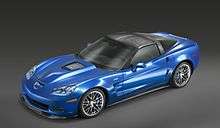
ZR1 was formally announced in a December 2007 press statement by General Motors, where it was revealed that their target of 100 bhp (75 kW) per 1 L (61 cu in) had been reached by a new "LS9" engine with an Eaton-supercharged 6.2-liter engine producing 638 bhp (476 kW) and 604 lb·ft (819 N·m). The LS9 engine was the most powerful to be put into a GM production sports car.[62] Its top speed was 205 mph (330 km/h).[63]

The historical name Grand Sport returned to the Corvette lineup in 2010 as an entirely new model series that replaced the Z51 option. The new model was basically an LS3 equipped Z06 with a steel frame instead of aluminum. It retained many of the features of the Z06 including a wide body with 18x9.5 and 19x12 inch wheels, dry sump oiling (manual transmission coupes only), 6-piston 14" front brakes and 4-piston rear, and improved suspension.[44] Manual power train equipped G/S coupe models receive a tweaked LS3 with a forged crank, are built in Z06 fashion by hand, and utilize a dry-sump oil system. The first three gears were also made shorter for better throttle response and faster acceleration.[64] A new launch control system was introduced for all models that allows for sub 4 second 0-60. EPA estimated 26 MPG highway, 1.0 G on skid pad.[16]
Beginning with the 2011 model year, buyers of the Corvette Z06 and ZR1 were offered the opportunity to assist in the build of their engine. Titled the "Corvette Engine Build Experience," buyers paid extra to be flown to the Wixom, Michigan Performance Build Center.[65] Participants helped the assembly line workers build the V8 engine, then took delivery of the car at the National Corvette Museum in Bowling Green, KY, near the Corvette final assembly point.[66]
The last C6 Corvette was manufactured in February 2013.[67][68]
In May 2013, a federal investigation of problems with more than 100,000 C6 lighting systems was announced.[69]
Seventh generation (C7; 2014–present)

The next-generation (C7) Corvette had been in development since 2007. Originally set to be introduced for the 2011 model year, its introduction was delayed for 3 years. It was finally released for the 2014 model year.[70] Mid-engine and rear-engine layouts had been considered, but the front-engine, rear-wheel drive (RWD) platform was chosen to keep production costs lower.[71]
To GM's product planners and marketers, the fact that the Corvette had become known as an "old man's toy" became a prime factor in developing the next generation. Studies showed that about 46 percent of Corvette buyers in 2012, through October, were 55 or older, compared with 22 percent of Audi R8 and 30 percent of Porsche 911 customers. The head of Chevy marketing, Chris Perry, acknowledges that too many people saw it as the car of "the successful plumber." John Fitzpatrick, Corvette's marketing manager said "It's the old saying, 'Nobody wants to be seen driving an old man's car, but everybody wants to be seen driving a young man's car.' "[43] To counter that perception GM planned to make the new generation C7 more aspirational to younger people. Towards that end, a camouflaged version of the car was made available in the popular video game Gran Turismo 5 in November 2012.[72] As part of the marketing effort associated with the introduction of the new generation, the 2013 Indianapolis 500 utilized a Corvette for the 12th time as its pace car.
Sales success of the new Corvette is important to GM. The Motley Fool reports that the Corvette could be earning GM $10,000 or more in gross profit for every Corvette it sells.[73] GM's profit on sales is separate from the profits made by the individual dealerships selling the cars to the public.
The 2014 Chevrolet Corvette uses an LT1 6.2 L V8 (376 cu in) making 455 bhp (339 kW) or 460 bhp (340 kW) with the optional performance exhaust. The LT1 engine (the "LT1" designation was first used by GM in 1970 and then later in 1992.) is in the Gen 5 family of small block engines, which will be used in GM vehicles as the new small V8 option. It features three technologies new to the GM V8, though widely available on other engines in the marketplace: direct injection, variable valve timing, and an active fuel management system. Fuel injectors are located under the intake manifold. The Corvette remains rear-wheel drive with the transaxle located in the rear. Transmission choices include a 7-speed manual or a 8-speed automatic with paddle shifters. The new interior includes wide-bottom seats as standard, with sportier versions with high side bolsters optional. The Corvette's flag logo has been revised for the new car and a small casting of a stingray has been added to the car's ornamentation.
Features of the new generation's structure include a carbon fiber hood and removable roof panel. The fenders, doors and rear quarter panels remain composite. At the rear of the car, the trademark round taillights have changed to a more squarish form. The underbody panels are made of "carbon-nano" composite and it makes use of a new aluminum frame which locates the four wheels an inch farther apart, front to rear and side to side. Luggage space decreased by 33% from the previous generation's.[74] The overall weight of the car was not announced by General Motors for many months after its first showing in January 2013. Despite the increased use of aluminum and other light weight materials, numerous publications reported that the weight would remain essentially unchanged from that of the previous generation's.[75][76][77] In August, 2013, the weight of the new Corvette was reported to be 3,444 lb (1,562 kg),[78] meaning it would weigh more than the previous generation's C6 ZR1 model (3,324 lb (1,508 kg)). The ZR1 C6 weight included a supercharger and intercooler on its 6.2L engine.[79]
Chevrolet announced the C7 Z06 at the 2014 Detroit Auto Show. The 2015 Z06 Corvette has 650 bhp from the supercharged LT4 aluminum 6.2L V-8 engine.[80][81]
The new generation Corvette resurrected the "Stingray" name (originally spelled "Sting Ray"), last used in 1976.[82]
For the 2015 model, Chevrolet began offering a transaxle version of the 8L90 8-speed automatic to replace the previous 6-speed 6L80.[83][84]
Similar to other car makes such as BMW and Tesla, Corvettes connected to Telematic Control Units may be hacked by outsiders.[85][86]
Awards
Over the years, the Corvette has won awards from automobile publications as well as organizations such as the Society of Automotive Engineers.
- Automobile Magazine ranked the 1963–1967 Sting Ray first on their "100 Coolest Cars" list, above the Dodge Viper GTS, the Porsche 911, and others.[87] In 2013, Automobile Magazine had selected the Corvette C7 as its "Automobile of the Year".[88]
- Sports Car International placed the Corvette at number 5 on their list of the "Top Sports Cars of the 1960s".
- Hot Rod magazine in its March 1986 issue selected the 1973–74 Corvette LS6 454 as one of the "10 most collectable muscle cars" in the company of the 1968–70 Chevelle, 1970 'Cuda, 1970 Challenger, 1966–67 Fairlane, 1968–70 AMX, 1970 Camaro Z28, 1968–70 GTO, 1968–69 Charger, and 1967–68 Mustang.[89]
- Car and Driver readers selected the Corvette "Best all around car" nine out of eleven years in Car and Driver's Reader's Choice Polls including 1971, 1972, 1973, 1974, and 1975.
- Car and Driver magazine selected the Corvette for its annual Ten Best list sixteen times: the C4 from 1985 through 1989, the C5 in 1998, 1999, and 2002 through 2004, the C6 from 2005 through 2009, and the C7 in 2014.
- Motor Trend magazine named the Corvette Car of the Year in 1984 and 1998.
- Society of Automotive Engineers publication Automotive Engineering International selected the 1999 Corvette Convertible, (along with the Mercedes-Benz S500) "Best Engineered Car of the 20th century".[90]
- The 2005 Corvette was nominated for the North American Car of the Year award and was named "Most Coveted Vehicle" in the 2006 Canadian Car of the Year contest.
- U.S. News & World Report[91] selected the 2010 Corvette the "Best Luxury Sports Car for the Money".
- Edmunds.com, in its "100 Best Cars Of All Time" list, ranked the 1963 Corvette Stingray as the 16th best car ever produced worldwide. The 1990 ZR1 took #50, the 1955 Corvette V8 took #72, and the 2009 ZR1 took #78 overall.
- "The 2014 Corvette was nominated for the North American Car of the Year award, and won it from its great performance."
NASA Corvettes
Astronaut Alan Shepard, a long time Corvette owner, was invited by then GM Chief Engineer Zora Arkus-Duntov to drive pre-production Corvette models. General Motors executives later gave Shepard a 1972 model with a Bill Mitchell interior. Jim Rathmann, a Melbourne, Florida Chevrolet dealer and winner of the 1960 Indy 500, befriended astronauts Shepard, Gus Grissom, and Gordon Cooper. Rathman convinced GM President Ed Cole to set up a program which supplied each astronaut with a pair of new cars each year. Most chose a family car for their wives and a Corvette for themselves.[92] In his memoir Last Man On The Moon, Gene Cernan describes how this worked. The astronauts received brand-new Corvettes which they were given the option to purchase at a 'used' price after they'd been driven 3000 miles. Alan Bean recalls Corvettes lined up in the parking lot outside the astronaut offices at the Johnson Space Center in Houston, and friendly races between Shepard and Grissom along the Florida beach roads and beaches themselves as local police turned a blind eye. [93] Shepard, Grissom and Cooper even pulled each other on skis in the shallow water. The Mercury and later astronauts were unofficially tied to the Corvette and appeared in official photographs with their cars and with mock-ups of space vehicles such as the Lunar Module or Lunar Rover. Cooper talked of the races along Cocoa Beach in his eulogy of Shepard at the Johnson Space Center in 1998.[94]
Concept cars
Corvette concept cars have inspired the designs of several generations of Corvettes.[95] The first Corvette, Harley Earl's 1953 EX-122 Corvette prototype was itself, a concept show car, first shown to the public at the 1953 GM Motorama at the Waldorf-Astoria Hotel in New York City on January 17, 1953. It was brought to production in six months with only minor changes.
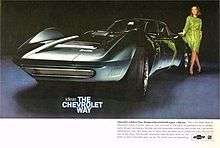
Harley Earl's successor, Bill Mitchell was the man behind most of the Corvette concepts of the 1960s and 1970s. The second-generation (C2) of 1963 was his, and its design first appeared on the Stingray Racer of 1959. It made its public debut at Maryland's Marlborough Raceway on April 18, 1959, powered by a 283 cu in (4.64 L) V8 with experimental 11:1 compression aluminum cylinder heads and took fourth place. It raced through 1960 wearing only "Sting Ray" badges before retiring to tour the auto-show circuit in 1961.[96]
In 1961 the XP-755 Mako Shark show car was designed by Larry Shinoda as a concept for future Corvettes. In keeping with the name, the streamlining, pointed snout, and other detailing was partly inspired by the look of that very fast fish. The 1961 Corvette tail was given two additional tail lights (six total) for the concept car. The body inspired the 1963 production Sting Ray.
In 1965 Mitchell removed the original concept body and redesigned it as the Mako Shark II. Chevrolet actually created two of them, only one of which was fully functional. The original Mako Shark was then retroactively called the Mako Shark I. The Mako Shark II debuted in 1965 as a show car and this concept influenced Mitchell's redesigned Corvette of 1968.
The Aerovette has a mid-engine configuration using a transverse mounting of its V-8 engine. Zora Arkus-Duntov's engineers originally built two XP-882s during 1969. John DeLorean, Chevy general manager, ordered one for display at the 1970 New York Auto Show. In 1972, DeLorean authorized further work on the XP-882. A near-identical body in aluminum alloy was constructed and became the XP-895 "Reynolds Aluminum Car." Duntov and Mitchell responded with two Chevrolet Vega (stillborn) Wankel 2-rotor engines joined together as a 4-rotor 420 hp (310 kW) engine which was used to power the XP-895. It was first shown in late 1973. The 4-rotor show car was outfitted with a 400 cu in (6.6 L) small-block V8 in 1977 and rechristened Aerovette. GM chairman Thomas Murphy approved the Aerovette for 1980 production, but Mitchell's retirement that year, combined with then Corvette chief engineer Dave McLellan's lack of enthusiasm for the mid-engine design and slow-selling data on mid-engined cars killed the last hope for a mid-engine Corvette.
A Corvette Stingray Anniversary concept car was unveiled at the 2009 Detroit Auto Show, fifty years after the Sting Ray racer-concept of 1959.[97] The vehicle was based on a combination of the 1963 Sting Ray and the 1968 Stingray. The new Stingray concept appears in the 2009 movie Transformers: Revenge of the Fallen, as the vehicle mode of the character Sideswipe.[98] A convertible/speedster version was used for the same character in the 2011 sequel, Transformers: Dark of the Moon.[99]
-
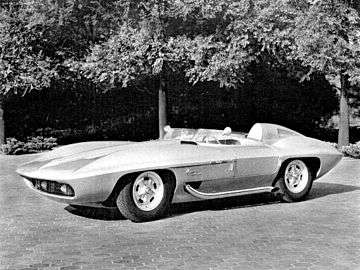
1959 Corvette XP-87 Stingray Racer concept
-
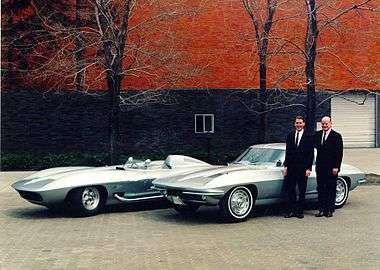
The XP-87 with a 1963 model and designer Bill Mitchell
-
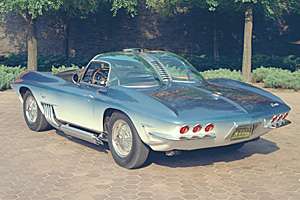
1961 Mako Shark concept
-

1965 Mako Shark II concept
-
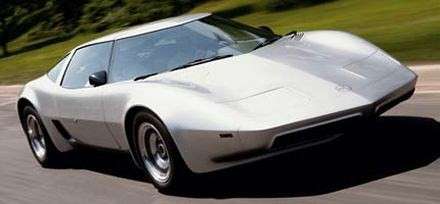
1977 Aerovette concept
-
.jpg)
2009 Corvette Stingray concept
Production
Production statistics from when the first generation of Corvettes were released in 1953 until present.[18]
| Year | Production | Notes | |
|---|---|---|---|
| C1 | 1953 | 300 | First generation (C1) begins; production starts on June 30; polo white with red interior and black top is only color combination; Options were interior door handles; "clip in" side curtains were a substitute for roll-up windows. |
| 1954 | 3,640 | Production moves to St. Louis; exterior colors-blue, red, and black are added; top color-beige is added, longer tail pipes. | |
| 1955 | 700 | Both inline-6 and 265 cu in (4.34 L) V8 engines produced; 3-speed manual transmission added late in the model year. | |
| 1956 | 3,467 | New body with roll-up windows; V8-only; 3-speed manual transmission becomes standard equipment and Powerglide moved to option list. | |
| 1957 | 6,339 | 283 cu in (4.64 L) V8; Optional 4-speed manual and fuel injected engine option added. | |
| 1958 | 9,168 | Quad-headlights and longer, face-lifted body; new interior and dash, fake louvers on hood and chrome strips on trunk lid; number of teeth in grille reduced from 13 to 9. | |
| 1959 | 9,670 | First black interior and dash storage bin; only year with a turquoise top; louvers and chrome strips from '58 removed. | |
| 1960 | 10,261 | Minor changes to the interior: red and blue bars on the dash logo, vertical stitching on seats. | |
| 1961 | 10,939 | New rear styling, bumpers, and round taillights. New fine-mesh grill. | |
| 1962 | 14,531 | 327 cu in (5.36 L) V8 engine; last year with a trunk until 1998. New black grill with chrome surround, chrome rocker panel moldings. | |
| 1963 | 21,513 | Second generation (C2) begins; new coupe body style introduced (only year for split rear window); coupe more expensive than convertible. | |
| C2 | |||
| 1964 | 22,229 | rear backlite windows of coupe changed to single pane window; hood louvers deleted. | |
| 1965 | 23,564 | 396 cu in (6.49 L) Big-Block V8 added; last year of fuel injected engine option (until 1982-std.); side-discharge exhaust introduced. Manufacturer colors change color code names. 4-wheel disc brakes introduced. | |
| 1966 | 27,720 | 427 cu in (7.00 L) Big-Block V8 with unique bulging hood; 327 cu in (5.36 L) 300 horsepower (220 kW) small block V8 standard. Head rests, 4-way hazard lights, day/night rear view mirror were not standard but were factory options. | |
| 1967 | 22,940 | five-louver fenders are unique; Big-Block hood bulge redesigned as a scoop; parking brake changed from pull-out under dash handle to lever mounted in center console; Tri-power 427 would become a sought-after Corvette. | |
| 1968 | 28,566 | Third generation (C3) begins; New body and T-top removable roof panels, new interior, engines carried over, three-speed Turbo Hydra-matic replaces two-speed Powerglide as automatic transmission option. | |
| C3 | |||
| 1969 | 38,762 | First year of the 350 cu in (5.7 L) Small-Block; longer model year extended to December, 1969 due to delay in introduction of 1970 model; "Stingray" front fender nameplates added, new interior door panels and inserts, 17-inch black-vinyl steering wheel (replaced 18-inch wood-rim wheel). | |
| 1970 | 17,316 | First year for the LT-1 Small-Block and 454 cu in (7.44 L) Big-Block; three-speed manual transmission dropped and four-speed manual became standard with Turbo Hydra-matic available as no-cost option with all engines except LT-1 350; posi-traction made standard equipment; introduced along with the second-generation Chevrolet Camaro on Feb. 26, 1970, new egg-grate metal front grills and fender grills, lower molded fender flares, new hi-back seats and interior trim, new custom interior option includes: leather seat trim, cut-pile carpeting, lower-carpeted door panels and wood-grain accents. | |
| 1971 | 21,801 | Significant power drops due to reduced compression ratios to meet GM corporate edict requiring all engines to run low-octane unleaded gasoline; power ratings based on both "gross" and "net" figures with the former based on engine hooked to dynometer while "net" ratings based on power as installed in vehicle with accessories and emission controls installed. | |
| 1972 | 27,004 | Power ratings now advertised in SAE net figures, last year for LT-1 engine, front and rear chrome bumpers, removable rear window, and windshield wiper door. | |
| 1973 | 30,464 | 5 mph (8.0 km/h) front bumper system with urethane cover, pot-metal front grills (black with silver edges), chrome rear bumpers unchanged, new design front fender ducts, first year for radial tires (standard equipment), rubber body mounts, new hood with rear air induction and under-hood insulation, new front-end (round) emblem. cross-flag gas-lid emblem deleted towards the end of the model year. | |
| 1974 | 37,502 | 5 mph (8.0 km/h) rear bumper system with urethane cover to match previous year's front bumper, new recessed taillamps and down-turned tail-pipes. 1974 is the only year with two piece rear bumper cover with center-split. No gas lid emblem was used. Aluminum front grills (all-black), dual exhaust resonators added, revised radiator cooling and interior a/c ducts, integrated seat /shoulder belts in coupe. Last year for true dual exhaust system, last year for the 454 big-block engine in a Corvette. | |
| 1975 | 38,465 | First year of Catalytic converter and single-exhaust, black (painted) bumper pads front and rear, redesigned inner-bumper systems and one-piece rear bumper cover, plastic front grills (all-black), amber parking lamp lenses (replaced the clear lenses on 1973–1974) new emblems, last year of C3 convertible. | |
| 1976 | 46,558 | First-year for steel floor-panels, cold-air induction dropped, new aluminum alloy wheels option, new one-piece rear "Corvette" nameplate (replaces letters). | |
| 1977 | 49,213 | Last year of 1968 flat rear glass design, Black exterior available (last year-1969), new design ""Corvette flags" front end and fender emblems. New interior console and gauges, universal GM radios. | |
| 1978 | 46,776 | 25th Anniversary, New fastback rear window, Silver Anniversary and Indy 500 Pace Car special editions; Pace-car included sport seats and spoilers-front and rear, limited option-glass t-tops; redesigned interior, dash, instruments. | |
| 1979 | 53,807 | Sport seats (from the previous year's pace-car); front and rear spoilers optional, glass t-tops optional; New interior comfort features; highest Corvette sales year to date. | |
| 1980 | 40,614 | Lightened materials, new hood, front end with molded spoilers, rear bumper cover with molded spoiler and new tail lamps, Federal government required 85 mph (137 km/h) speedometer; California cars powered by 305 V8 and automatic transmission for this year only, last year for L-82 engine- (n/a with manual transmission) | |
| 1981 | 40,606 | Production is switched from St. Louis to new Bowling Green plant; 350 cu in (5.7 L) V8 returns in California cars, last year for manual transmission. | |
| 1982 | 25,407 | New cross-fire fuel-injected L83, New automatic overdrive transmission; Collectors Edition features exclusive hatch rear window – is one fourth of production. | |
| 1984 | 51,547 | Fourth generation (C4) begins; hatchback body; digital instrumentation L83 engine continued from 1982. | |
| C4 | |||
| 1985 | 39,729 | More powerful and fuel efficient L98 engine introduced. | |
| 1986 | 35,109 | First convertible since 1975. Third brake light, antilock brakes, and key-code anti-theft system are new. | |
| 1987 | 30,632 | Callaway twin-turbo offered through dealers with GM warranty. | |
| 1988 | 22,789 | New wheel design; all white 35th Anniversary special edition coupe. | |
| 1989 | 26,412 | ZF 6-speed manual replaces Doug Nash 4+3. | |
| 1990 | 23,646 | ZR-1 is introduced with DOHC LT5 engine. Interior redesigned to incorporate drivers-side air bag. | |
| 1991 | 20,639 | Restyled exterior; last year for the Callaway B2K twin turbo. | |
| 1992 | 20,479 | New LT1 engine replaces the L98; Traction control is standard. | |
| 1993 | 21,590 | Passive keyless entry is standard; 40th Anniversary special edition in Ruby Red. | |
| 1994 | 23,330 | New interior including passenger airbag. LT1 engine gains mass air flow metered SFI. | |
| 1995 | 20,742 | Last year of the ZR-1; minor exterior restyling; Indy Pace Car special edition. | |
| 1996 | 21,536 | Optional LT4 engine with 330 bhp (246 kW). Collectors Edition and Grand Sport special editions. First year with OBD II diagnostics. | |
| 1997 | 9,752 | Fifth generation (C5) begins; LS1 engine is new; the hatchback coupé is the only body style offered. | |
| C5 | |||
| 1998 | 31,084 | Convertible C5 debuts with the first trunk in a Corvette convertible since 1962; Indianapolis 500 Pace Car replica offered; Active Handling System introduced as optional equipment. | |
| 1999 | 33,270 | Less-expensive hardtop coupé is offered. | |
| 2000 | 33,682 | Newly styled alloy wheels debut. | |
| 2001 | 35,627 | Hardtop coupé body style becomes top-performance Z06, utilizing the new LS6 engine and suspension improvements; Second-Generation Active Handling System becomes standard equipment on all models; slight (5 bhp (3.7 kW)) increase in base model engine power. | |
| 2002 | 35,767 | 20 bhp (15 kW) increase for the Z06 to 405 bhp. | |
| 2003 | 35,469 | 50th Anniversary Edition package offered for Coupe and Convertible base models; F55 Magnetic Selective Ride Control Suspension supersedes F45 Selective Ride Control Suspension as base-model option. | |
| 2004 | 34,064 | 24 Hours of Le Mans Commemorative Edition package offered for all models. | |
| 2005 | 37,372 | Sixth generation (C6) begins; New body is first with fixed headlamps since 1962; no Z06 model and a late convertible introduction. | |
| C6 | |||
| 2006 | 34,021 | Z06 debuts; 6-speed automatic with paddle shift available on non-Z06 models. | |
| 2007 | 40,561 | 6-speed automatic paddle shift delays are reduced drastically compared to 2006. | |
| 2008 | 35,310 | Mild freshening, LS3 introduced, All leather interior added (4LT, LZ3). | |
| 2009 | 16,956 | ZR1 model added, new "Spyder" wheels for Z06. | |
| 2010 | 12,194 | Grand Sport Coupe and Convertible added; replaces the Z51 performance package, launch control standard on MN6 models. | |
| 2011 | 13,596 | Wheel choices are updated; Larger cross-drilled brake rotors (13.4" front and 12.8" rear) available on Coupe and Convertible, or included with (F55) Magnetic Selective Ride Control. Z07 Performance Package introduced for Z06. | |
| 2012 | 11,647 | Upgraded interior and new tires on the base model. Z06 acquires full-length rear spoiler and a carbon fiber hood as options. ZR1 gets adjusted gears for better fuel economy. ZR1 Performance Package introduced, Z07 Performance Package tweaked with new wheels. | |
| 2013 | 13,466 | Introduction of 427 Convertible model. 9 month production run. | |
| 2014 | 37,288 | Seventh generation (C7) begins; All new styling, chassis and drivetrain. | |
| C7 | |||
| 2015 | 34,240 | C7 Z06 debuts. | |
| 2016 | 27,327 | The C7 Grand sport was added to debut. | |
| Total | 1,595,026 | ||
Owner demographics
According to research by Specialty Equipment Market Association and Experian Automotive, as of 2009, there were approximately 750,000 Corvettes of all model years registered in the United States. Corvette owners were fairly equally distributed throughout the country, with the highest density in Michigan (3.47 per 1000 residents) and the lowest density in Utah, Mississippi, and Hawaii (1.66, 1.63, and 1.53 registrations per 1000 residents). 47% of them hold college degrees (significantly above the nationwide average of 27%), and 82% are between ages of 40 and 69 (median age being 53).[100]
Racing
C5-R
The Chevrolet Corvette C5-R is a grand touring racing car built by Pratt & Miller and General Motors for competition in endurance racing. The car is based on the C5 generation of the Chevrolet Corvette sports car, yet is designed purely for motorsports use.[101] It became one of the most dominant cars in GT categories, with wins at the 24 Hours of Daytona, 12 Hours of Sebring, and 24 Hours of Le Mans, as well as championships in the American Le Mans Series.[102] The Corvette C5-Rs debuted in 1999 and continues to be raced to this day, although the C5-R has effectively been replaced by the Corvette C6.R.[103]
C6.R
C6.R GT1 (Z06) In 2005, the factory Corvette Team began racing the C6.R to coincide with the new sixth generation (C6) Corvette being released to the public. Private teams, primarily in Europe, continued to race the C5-R for a couple of years before switching to the C6.R. Corvette C6.R went on to win its class at every race it entered in the 2005 ALMS season.[104] By the end of 2009, Corvette had clinched four consecutive ALMS GT1 team and manufacturers titles (2005–2008) and three Le Mans 24 Hour class victories in the LMGT1 category (2005, 2006, 2009). 2007 and 2008 races were won by the factory Aston Martin squad's DBR9. The last official race for factory GT1 Corvettes was the 2009 24 Hours of Le Mans.[105]
C6.R GT2 (ZR1) While some privateers continued to use GT1 version of the C6.R in Europe, the official factory team Corvette Racing switched from the slowly dying GT1 category to the much more competitive and popular GT2 class in mid-2009. The new GT2 C6.R used a modified version of the ZR1 model body, but does not have the ZR1 supercharged engine. GT2 rules are based more on production vehicles, therefore the GT2 C6.R naturally aspirated engine was considerably more restricted and less powerful than its predecessor. The car debuted at Mid-Ohio's ALMS round. They achieved one ALMS race victory in the remaining 2009 ALMS season, and one victory at the final round of 2010 ALMS season, Petit Le Mans. Corvette Racing's two GT2 C6.Rs also led most of the 2010 24 Hours of Le Mans, but both cars were forced to retire. Racing in the new GTE Pro class, the C6.R raced in the 2011 24 Hours of Le Mans with the No. 73 car taking the class victory. The No. 74 car led the class for most of the race but crashed in the morning hours. The C6.R raced by Larbre Competition also took the GTE Am class victory.[106] In 2012, Corvette Racing returned to glory in the ALMS winning 4 of 10 races and claiming the Driver's, Team, and Manufacturer's Championships. Corvette Racing repeated the feat in 2013 by winning 5 of 10 races and claiming the Driver's, Team and Manufacturer's Championships again.
C7.R
.jpg)
In 2014, Corvette Racing introduced the new C7.R to coincide with the launch of the seventh-generation C7 Corvette. The car made its on track debut at the 2013 Rolex Motorsports Reunion and later participated in the 2014 Roar Before the Rolex 24 to prepare for the 2014 United SportsCar Championship. The car's new livery was debuted at the 2014 North American International Auto Show. In 2015, the Corvette Racing C7.R took class victories at both the 24 Hours of Daytona and the 24 Hours of Le Mans.
Indianapolis 500 pace cars
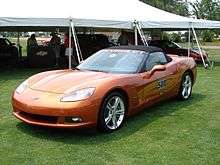
A Corvette has been selected as the pace car at the Indianapolis 500, 13 times.[107] The 2008 edition of the Indy 500 represented a record fifth-consecutive year to lead the field until 2009 when the Chevrolet Camaro SS was selected. The Corvette's pace car years and details include:
- 1978 – Driven by 1960 race winner Jim Rathmann; Chevrolet produced 6,502 production replicas.
- 1986 – Driven by famed pilot Chuck Yeager; all 7,315 production convertibles were considered pace car convertibles and included official graphics (to be installed at the owner's discretion).
- 1995 – Driven by then Chevrolet General Manager Jim Perkins; 527 production replicas produced.
- 1998 – Driven by 1963 race winner Parnelli Jones when an injury prevented golfer Greg Norman from performing the duty; 1,158 production replicas produced.
- 2002 – Driven by actor Jim Caviezel; no production replicas produced but graphics were available through SPO – approximately 300 sets sold.
- 2004 – Driven by actor Morgan Freeman; no production replicas produced.
- 2005 – Driven by General Colin Powell; no production replicas produced.
- 2006 – Driven by cycling champion Lance Armstrong; first Corvette Z06 pace car; no production replicas produced.
- 2007 – Driven by actor Patrick Dempsey; 500 production replicas – all convertibles.
- 2008 – Driven by Emerson Fittipaldi; 500 production replicas – coupes and convertibles.
- 2012 – Driven by Guy Fieri; first Corvette C6 ZR1 pace car; no production replicas produced.
- 2013 – Driven by Jim Harbaugh; first year of production for C7 generation.
- 2015 - Driven by Jeff Gordon; first Chevrolet Corvette C7 Z06 pace car
See also
- Chevrolet Engineering Research Vehicle
- Kaiser Darrin, prototype in 1952, 435 built for 1954 model year
- Nash-Healey, 1951–54
- National Corvette Museum
References
- ↑ "Vette magazine - Super Chevy".
- ↑ "2017 Corvette Stingray: Sports Cars - Chevrolet".
- ↑ Book: "The Real Corvette:An Illustrated History Of Chevrolet's Sports Car", Authors: Ray Miller + Glenn Embree, ISBN 0913056065
- ↑ Falconer, Tom (2003). The Complete Corvette. Crestline. p. 9. ISBN 978-0-7603-1474-6. Retrieved Sep 30, 2012.
- 1 2 3 Emanuel, Dave (2002). Corvette Tech Q & A. Penguin. ISBN 1557883769.
- 1 2 Porter, Lindsay (1997). Chevrolet Corvette Restoration Guide. MotorBooks International. p. 256. ISBN 0760303258.
- 1 2 "Chevrolet Corvette History". Edmunds. Retrieved 2013-03-29.
- ↑ Mueller, Mike (2003). Classic Corvette 30 Years. Crestline Imprints. p. 384. ISBN 0760318069.
- ↑ Prince, Richard (2002-08-08). Corvette Buyers Guide, 1953-1967. MotorBooks International. p. 192. ISBN 0760310092.
- ↑ W. Passon, Jerry (2011). The Corvette in Literature and Culture: Symbolic Dimensions of America's Sports Car. McFarland. p. 246. ISBN 0786462841.
- 1 2 Gunnell, John (2004). Standard Guide To 1950s American Cars. Krause Publications. p. 256. ISBN 0873498682.
- ↑ Christian Science Monitor Newspaper, Article "Chevrolet Restyles Sleek 1956 Corvette", Feb 20, 1956, p.22
- ↑ 1956 GM Year-End Annual Report, pg 15
- 1 2 3 4 5 6 Gunnell, John (2004). Standard catalog of Corvette, 1953-2005 (Second ed.). Krause Publications. ISBN 0873499077.
- 1 2 3 Staff of Old Cars Weekly (2010). Corvette – The Great American Sports Car. Krause Publications. p. 208. ISBN 1440215510.
- 1 2 Gunnell, John (2011). Standard Catalog of Chevrolet, 1912-2003: 90 Years of History, Photos, Technical Data and Pricing. F+W Media. ISBN 1440230552.
- ↑ Antonick, Mike (2006). Corvette Black Book, 1953-2007. MotorBooks International. pp. 44–45. ISBN 0760328943.
- 1 2 Gunnell, John (2011). Standard Catalog of Chevrolet – 3rd Edition. Krause Publications. ISBN 1440227934.
- 1 2 3 4 Antonick, Mike (2006). Corvette Black, Books 1953-2007. MotorBooks International. ISBN 0760328943.
- 1 2 3 Mueller, Mike (2009). The Corvette Factories: Building America's Sports Car. MotorBooks International. ISBN 978-0-7603-3551-2.
- ↑ Magazines, Hearst (March 2003). "50 Corvette". Popular Mechanics: 61. ISSN 0032-4558.
- ↑ Newton, Richard (1999). Corvette Restoration Guide, 1963-1967. MotorBooks International. p. 18. ISBN 978-0-7603-0179-1.
- ↑ DieCastX Magazine. Air Age. 2007.
- ↑ "Street Machines and Bracket Racing". Hot Rod (5): 77. 1981.
- ↑ Super Street Cars. Super Street Cars. p. 35.
- 1 2 3 Staff of Old Cars Weekly (2010). Nothin' but Muscle. Krause Publications. p. 34. ISBN 978-1-4402-1549-0.
- ↑ "Driving the New Corvette". Popular Mechanics. September 1988. ISSN 0032-4558.
- ↑ Leffingwell, Randy (2002). Corvette Fifty Years. MBI Publishing. p. 203. ISBN 0-7603-1180-3.
- ↑ Flory, Jr., J. "Kelly" (2004). American Cars, 1960–1972: Every Model, Year by Year. McFarland. p. 505. ISBN 978-0-7864-1273-0.
- ↑ Flory, p.509.
- ↑ Popular Mechanics. Hearst Magazines. 2003. ISSN 0032-4558.
- ↑ Friedman, Dave (2004). Corvette Grand Sport. MotorBooks International. ISBN 978-0-7603-1926-0.
- ↑ "1963 Chevrolet Corvette Grand Sport". simeonemuseum.org.
- ↑ Popular Mechanics. Hearst Magazines. 1977. ISSN 0032-4558.
- ↑ Corvette 50th Anniversary-specifications and performance-by the Editors of Consumer Guide
- ↑ Flory, p.734.
- ↑ Auto Editors of Consumer Guide (2007-06-07). "1971 Corvette". auto.howstuffworks.com. Retrieved Sep 30, 2012.
- ↑ Antonick, Mike (2006). Corvette Black, Books 1953-2007. MotorBooks International. ISBN 978-0-7603-2894-1.
- ↑ Mann, James; Falconer, Tom (2010). Corvette 1968-1982. Motorbooks. ISBN 978-0-7603-3747-9.
- ↑ McNicholl, George A. (2007). How to rebuild Corvette rolling chassis 1963-1982. Motorbooks. p. 14. ISBN 978-0-7603-3014-2.
- ↑ "Internet Archive Wayback Machine". Web.archive.org. July 16, 2011. Archived from the original on 2011-07-16. Retrieved Sep 30, 2012.
- ↑ "Library and Archives". National Corvette Museum. Retrieved 8 December 2012.
- 1 2 "Redesign intended to re-establish Corvette's cool factor". Chicago Tribune. Archived from the original on 13 January 2013. Retrieved 13 January 2013.
- 1 2 Mueller, Mike. The complete book of Corvette : every model since 1953. Motorbooks. ISBN 0760341400.
- ↑ Connell, Bill. "The Missing 1983 Corvette". Corvette Blog. Retrieved 2012-11-29.
- ↑ "Local News - The Courier-Journal - courier-journal.com". The Courier-Journal.
- 1 2 Newton, Richard (2003). 101 projects for your Corvette : 1984-1996. Motorbooks International. ISBN 0760314616.
- ↑ Cangialosi, Paul (2010). How to rebuild and modify high-performance manual transmissions. CarTech. ISBN 1934709298.
- ↑ "1987 Twin Turbo Callaway Corvette". Corvette Action Center. Retrieved Sep 30, 2012.
- ↑ "1990 Twin Turbo Callaway Corvette". Corvette Action Center. Retrieved Sep 30, 2012.
- ↑ Mueller, Mike (1996). Corvette milestones. Motorbooks International. ISBN 076030095X.
- ↑ Pace, Harold. "The Immortal Corvette: 1997-2003". autoMedia.com. Retrieved 30 September 2012.
- ↑ Thurn, Walt (2007). High-performance C5 Corvette builder's guide. CarTech. ISBN 1932494332.
- ↑ Newton, Richard (2006). Corvette C5 performance projects. MBI Pub. p. 8. ISBN 0760320810.
- ↑ Schefter, pp. 96, 105, 108.
- ↑ Mueller, Mike (2004). Essential musclecars. St. Paul, MN: Motorbooks International. ISBN 0760319669.
- ↑ Endres, Christopher P. (1996). Chevy LS1/LS6 performance : high performance modifications for street and racing : covers Chevy LS1 and LS6 engines, 1997 and up (1st ed.). New York, N.Y.: HP Books. ISBN 1557884072.
- ↑ Berg, Phil (2004). Corvette C6. St. Paul, MN: Motorbooks International. ISBN 0760318654.
- ↑ "The Corvette Story". Archived from the original on 2012-09-18. Retrieved Sep 30, 2012.
- ↑ "First Drive: 2006 Chevrolet Corvette Z06". Insideline.com. August 31, 2005. Retrieved Sep 30, 2012.
- ↑ "First Drive: 2008 Chevrolet Corvette". Edmunds.com. Apr 27, 2007. Archived from the original on August 18, 2012. Retrieved Nov 22, 2008.
- ↑ Marty Jerome (Apr 25, 2008). "The Numbers Are In: Corvette ZR1 Cranks Out 638 HP". Wired (Autopia). Retrieved Sep 30, 2012.
- ↑ "2009 Corvette ZR1 Power Numbers Finalized: LS9 V8 Hits 638 HP!".
- ↑ "2010 Chevrolet Corvette Grand Sport First Drive".
- ↑ Earnest, Brian (2010). Corvette the great American sports car. Iola, WI: Krause Publications. ISBN 144021753X.
- ↑ "2011 Chevy Corvette Engines Can be Built by Owner". Automoblog.net. Retrieved Sep 30, 2012.
- ↑ "End of the C6 1Q 2013 – Corvette Forum". Forums.corvetteforum.com. Retrieved 2013-01-25.
- ↑ "Last 2013 c6 vette 2/2013 and 1st C7 August/September 2012". Autoweek. Retrieved Dec 11, 2012.
- ↑ Florea, Ciprian (May 10, 2013). "C6 Corvette Under Investigation over Faulty Headlamps". Autoevolution. Retrieved February 18, 2015.
- ↑ "Spied: 2014 Chevrolet C7 Corvette". Automobile Magazine. January 2012. Archived from the original on 2012-02-22.
- ↑ Connor, Mike (December 2008). "No Mid-Engine For Chevrolet Corvette C7". Motor Trend. Retrieved Sep 30, 2012.
- ↑ Higgins, Tim (2013-01-11). "Corvette Not Just for Successful Plumbers With New Design". Bloomberg. Retrieved 2013-01-25.
- ↑ Adam Levine-Weinberg (2013-11-09). "The 2014 Corvette Stingray Steps on the Gas". Motley Fool. Retrieved 2013-11-18.
- ↑ Phelan, Mark. "2014 Chevrolet StingRay Review". Chicago Tribune. Archived from the original on 2013-11-10. Retrieved 2013-11-10.
- ↑ Ulrich, Lawrence (February–March 2013). Corvette C7. Road & Track Magazine. p. 47.
- ↑ Paukert, Chris (2013-01-13). "2014 Chevrolet Corvette C7 Stingray, everything there is to know". Autoblog. Retrieved 2013-03-29.
- ↑ Krisher, Tom (2013-01-13). "C7 Corvette, 2014 Model, Bursts Onto The Road After 9 Years". Huffington Post. Archived from the original on 2013-01-17. Retrieved 2013-03-29.
- ↑ Webster, Larry (September 2013). 2014 Corvette. Road & Track Magazine. p. 44.
- ↑ "2012 Chevrolet Corvette ZR1". Chevrolet. Retrieved 2011-12-01.
- ↑ Los Angeles Times, "Detroit Auto Show: Corvette Stingray Z06 debuts with 600-plus horsepower", January 13, 2014, http://www.latimes.com/business/autos/la-fi-hy-detroit-auto-show-corvette-20140113,0,1175087.story#axzz2qkvC2rdw
- ↑ Chevrolet 2015 Corvette website, http://www.chevrolet.com/2015-corvette-stingray-z06-supercar.html
- ↑ "Next-generation Corvette to Debut 1.13.13 in Detroit". media.gm.com.
- ↑ Colwell, K.C. "2015 Chevrolet Corvette Stingray Eight-Speed Automatic". Car and Driver. Retrieved 18 June 2015.
- ↑ "New 8-Speed Enables Quicker, More Efficient Corvette". www.gm.com. General Motors. 20 August 2014. Archived from the original on 22 December 2014. Retrieved 21 August 2014.
- ↑ 02:39, 12 Aug 2015 at; tweet_btn(), Darren Pauli. "TXT message leaves Corvette wrecked".
- ↑ https://www.usenix.org/system/files/conference/woot15/woot15-paper-foster.pdf
- ↑ "Features: 100 Coolest Cars". Automobile Magazine. p. 3. Archived from the original on 2012-02-05. Retrieved Sep 30, 2012.
- ↑ CNN Money,"Corvette named Automobile of the Year", Author: Peter Valdes-Dapena, November 16th 2013, http://money.cnn.com/2013/11/16/autos/corvette-automobile-magazine-car-of-the-year/
- ↑ Hot Rod. Hot Rod. 1986.
- ↑ "Best Engineered Car of the 20th century". Sae.org. Retrieved Sep 30, 2012.
- ↑ Deaton, Jamie Page (Dec 11, 2009). "Best Cars for the Money 2010". U.S. News & World Report. Archived from the original on 2009-03-12. Retrieved Sep 30, 2012.
- ↑ Bean, Alan. "Training".
- ↑ Nelson, John (June 2009). "The AstroVette an astronaut's Corvette from the beginning of the Space Age". Vette.
- ↑ French, Francis; Burgess, Colin; Haney, Paul (2009). Into That Silent Sea: Trailblazers of the Space Era, 1961–1965. Bison Books. p. 261. ISBN 0-8032-2639-X.
- ↑ auto editors of Consumer Guide (2003). Corvette: 50th anniversary. Publications International. ISBN 0785379878.
- ↑ Leffingwell, Randy (2002). Corvette: fifty years. MBI. ISBN 9780760311806.
- ↑ Friends magazine-published by Chevrolet for Corvette owners. Chevrolet.
- ↑ "Corvette Stingray Concept: Sideswipe In Disguise". Jalopnik.com. Feb 11, 2009. Retrieved Sep 30, 2012.
- ↑ "Transformers "Dark of the Moon" Sideswipe, Bumblebee: First Look". Jalopnik.com. May 16, 2011. Retrieved Nov 14, 2012.
- ↑ "Vette Owners Quick to Customize". SEMA. Jan 15, 2009. Archived from the original on 2013-05-11. Retrieved Sep 30, 2012.
- ↑ Popular Mechanics. Hearst Magazines. 1991. p. 156. ISSN 0032-4558.
- ↑ Popular Mechanics. Hearst Magazines. 1999. p. 156. ISSN 0032-4558.
- ↑ DeLorenzo, Matt (2007). The Corvette Dynasty. Chronicle Books. p. 160. ISBN 978-1-932855-82-1.
- ↑ "2011 Chevrolet Corvette Z06 Carbon vs. 2010 Corvette Grand Sport vs. 2002 Corvette Z06 Comparison Test and Video". Retrieved 10 October 2012.
- ↑ "Pratt & Miller Engineering Introduces Corvette C6RS Supercar for the Street". Corvette C6RS. Archived from the original on 23 March 2013. Retrieved 10 October 2012.
- ↑ Schilke, Nancy. "Shanghai victory sees Larbre Competition crowned GTE Am world champions". Race reports. Retrieved 8 December 2012.
- ↑ "Indianapolis 500 Pace Cars". Indianapolis Motor Speedway. 2008. Retrieved Sep 30, 2012.
- Nichols, Richard. Corvette: 1953 to the Present. London: Bison Books, 1985. ISBN 0-86124-218-1.
External links
| Wikimedia Commons has media related to Chevrolet Corvette. |
| Chevrolet Corvette timeline, 1953–present | ||||||||||||||||||||||||||||||||||||||||||||||||||||||||||||||||
|---|---|---|---|---|---|---|---|---|---|---|---|---|---|---|---|---|---|---|---|---|---|---|---|---|---|---|---|---|---|---|---|---|---|---|---|---|---|---|---|---|---|---|---|---|---|---|---|---|---|---|---|---|---|---|---|---|---|---|---|---|---|---|---|---|
| Type | 1950s | 1960s | 1970s | 1980s | 1990s | 2000s | 2010s | |||||||||||||||||||||||||||||||||||||||||||||||||||||||||
| 3 | 4 | 5 | 6 | 7 | 8 | 9 | 0 | 1 | 2 | 3 | 4 | 5 | 6 | 7 | 8 | 9 | 0 | 1 | 2 | 3 | 4 | 5 | 6 | 7 | 8 | 9 | 0 | 1 | 2 | 3 | 4 | 5 | 6 | 7 | 8 | 9 | 0 | 1 | 2 | 3 | 4 | 5 | 6 | 7 | 8 | 9 | 0 | 1 | 2 | 3 | 4 | 5 | 6 | 7 | 8 | 9 | 0 | 1 | 2 | 3 | 4 | 5 | 6 | |
| 3-box coupe | C2 | C3 | C5 | |||||||||||||||||||||||||||||||||||||||||||||||||||||||||||||
| Fastback coupe | C3 | C4 | C5 | C6 | C7 | |||||||||||||||||||||||||||||||||||||||||||||||||||||||||||
| Convertible | C1 | C2 | C3 | C4 | C5 | C6 | C7 | |||||||||||||||||||||||||||||||||||||||||||||||||||||||||
| Performance | Fuel Injection | Z06 | Big Block | ZR-1 | LT4 | Z06 | Z06 | Z06 | ||||||||||||||||||||||||||||||||||||||||||||||||||||||||
| L84 | Big Block | LT1 | ZR1 | |||||||||||||||||||||||||||||||||||||||||||||||||||||||||||||
| Motorsports: Grand Sport • GTP • C5-R • C6.R • C7.R | ||||||||||||||||||||||||||||||||||||||||||||||||||||||||||||||||